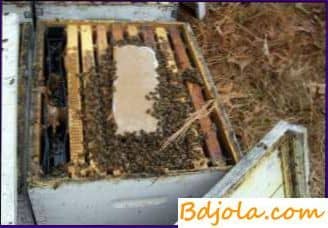How to place stern frames in hives for the winter

It was already noted that for a bee family in the autumn-winter-spring period, 25-30 kg of feed (honey, sugar) should be prepared. However, in hives for winter, not all food should be left, but only as much as it is placed in honeycombs occupied by bees. A strong family is left with 8-9 honeycombs, a middle one – 6, families (nucleuses) with spare uterus – 3-4 honeycombs. All honeycombs left in the nests should be filled with printed honey not less than half, that is, not less than 1.5 kg of feed.
During the winter, the club of bees gradually moves upwards. This is a natural movement that is painless for the family. If, in the middle of the nest, the beekeeper, by oversight, leaves 1-2 honeycombs with a small amount of honey, then, having consumed all the honey on these honeycombs, the bees begin to worry, and the calm wintering of the bees will be disturbed. In the club, the temperature will rise, and bees from honeyless honeycombs will move to neighboring honeycombs, where there is food. As a result, the whole club of bees will move to other honeycombs. Moving the same bees across the nest is always associated with a large intake of food and a violation of their normal wintering.
But the presence of malomednyh honeycombs can lead to a disastrous for the family bifurcation of the club: one part of the bees will go in one direction, the other in the opposite direction, as a result in the nest there will be 2 small, divorced from each other club, which, as very weak, perish. Sometimes the club of bees turns in the direction where there are few fodder reserves and, having consumed them, perishes. Therefore, it is necessary to place the honeycomb for winter so that the club of bees is not gathered in the middle of the nest, but closer to its edge. To do this, after the end of the honey collection in the hive leave the tray is not in the middle of the hive, but closer to its southern
Before feeding from the hives, the excess honeycombs are removed. In the nest, only honeycombs containing about 1.5-2 kg of honey and honeycomb with brood are left. Later, when the number of broods in the families decreases, once more they inspect the nests and select the honeycombs from which all the brood came out and contains little honey. The remaining honeycombs bring together and, if necessary, add more honey combs, placing them on the side of the nest. Then on whatever cell the club is formed, the bees in the cold period will have enough food in each street and the club will not have to move among the winter from one frame to another.
When forming the nests leave 2-3 frames with Perga. These frames are placed on the second places from the edges.
Preparation for the wintering of bee colonies contained in hives-sunbeds does not fundamentally differ from their preparation when kept in 12-frame hives. Using a large amount of a hive-lodge, beekeepers often keep 2 families in it in winter. In this case, the hive is carefully fenced in half with a sheet of plywood. The flocks of both families should be in one front wall of the hive and, if possible, closer to the general partition, so that the club of each of them is located in the closest proximity to each other.
Bee families in the multi-hull beehives usually occupy 3-4 corps to the beginning of the honey crop. Before the main honey collector the bodies are exchanged in places so that the shells with the brood are at the bottom, and with empty honeycombs – at the top. The strongest families are added another body with honeycombs. By the end of the honey collection, the upper 2 – 3 corps are filled with honey. One of them, containing 18-20 kg of honey, is left to bees for the winter; The remaining cases are selected and the honey is pumped out. During the autumn and winter, bee colonies are kept in two buildings (the upper one – with fodder honeycombs, and the lower one – with malomed honeycombs and brood). The summer is opened in the second building.
If bees in this zone often collect fallow honey, then after the end of the honey collection of the housing with benign fodder honey, select and store them in the warehouse until the danger of bringing inadequate honey is eliminated. At the end of the season, the upper hulls, in which there may be pade honey, are selected, and previously harvested casings with flower honey are put in their place.
In late August – early September, families are given 4 kg of sugar. Before the beginning of the feeding, excess corps is selected and the families of the bees are left in two buildings.
Feeders use the upper, placing them in an empty, third body.
How to place stern frames in hives for the winter
